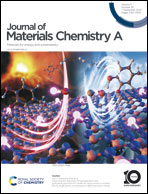Improving the selectivity of hydrogenation and hydrodeoxygenation for vanillin by using vacancy-coupled Ru–N3 single atoms immobilized on defective boron nitride†
Abstract
The coordination and geometric engineering of SACs will provide a novel approach to advanced catalysts for energy related applications. Hexagonal boron nitride (h-BN) is a stable graphene-like material with a high specific surface area and is expected to be an excellent support for single atom catalysts (SACs). The regulatory mechanism of isolated metal active sites on the h-BN matrix is still ambiguous, including the significance of the defect effect. Herein, we report a neoteric ruthenium single-site catalyst supported on vacancy-affluent porous h-BN, where Ru is coordinated with three nitrogen atoms (Ru-SA/pBN-VN) for selective vanillin conversion reactions with high efficiency. X-ray absorption fine structure (XAFS) results based on synchrotron radiation and density functional theory (DFT) calculations suggest that the nitrogen vacancy adjacent to the active Ru–N3 center has a strong atomic interface regulation effect. Derived from the remarkable metal–support interaction, Ru-SA/pBN-VN shows excellent conversion (∼100%) and selectivity (∼100%) in temperature-dependent hydrogenation (obtaining vanillyl alcohol at 60 °C) and hydrodeoxygenation (gaining 2-methoxy-p-cresol at 120 °C) reactions of vanillin, also with superb catalytic stability. We propose an innovative perspective that the strongly coupled metal–ligand moiety with an adjacent vacancy may play synergistic roles in heterogeneous catalysis.



 Please wait while we load your content...
Please wait while we load your content...